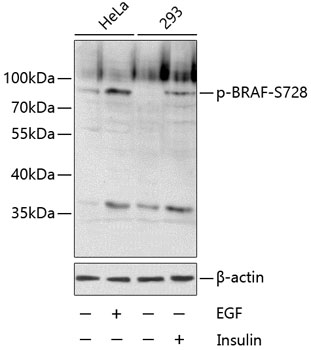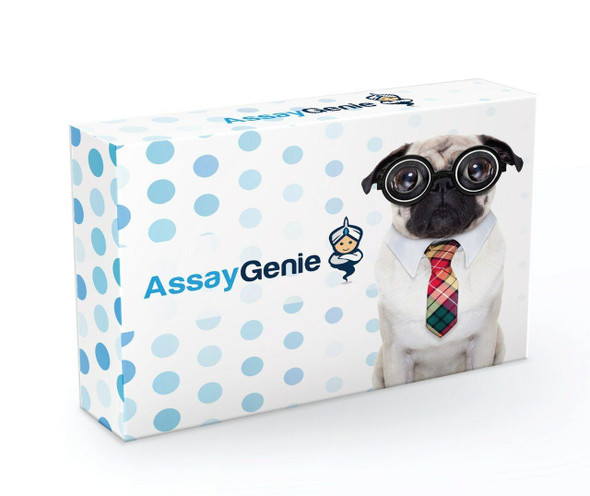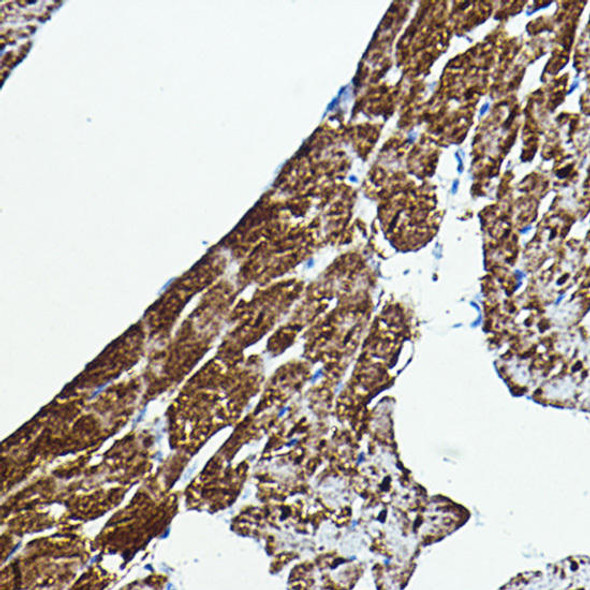Cell Biology Antibodies 16
Anti-Phospho-BRAF-S728 Antibody (CABP0576)
- SKU:
- CABP0576
- Product Type:
- Antibody
- Applications:
- WB
- Reactivity:
- Human
- Host Species:
- Rabbit
- Isotype:
- IgG
- Research Area:
- Cell Biology
Description
| Antibody Name: | Anti-Phospho-BRAF-S728 Antibody |
| Antibody SKU: | CABP0576 |
| Antibody Size: | 20uL, 50uL, 100uL |
| Application: | WB |
| Reactivity: | Human |
| Host Species: | Rabbit |
| Immunogen: | A synthetic phosphorylated peptide around S728 of human BRAF (NP_004324.2). |
| Application: | WB |
| Recommended Dilution: | WB 1:500 - 1:2000 |
| Reactivity: | Human |
| Positive Samples: | HeLa, HeLa+EGF, 293, 293+Insulin |
| Immunogen: | A synthetic phosphorylated peptide around S728 of human BRAF (NP_004324.2). |
| Purification Method: | Affinity purification |
| Storage Buffer: | Store at -20°C. Avoid freeze / thaw cycles. Buffer: PBS with 0.02% sodium azide, 50% glycerol, pH7.3. |
| Isotype: | IgG |
| Sequence: | SASE P |
| Gene ID: | 673 |
| Uniprot: | P15056 |
| Cellular Location: | Cell membrane, Cytoplasm, Nucleus |
| Calculated MW: | 84kDa |
| Observed MW: | 86kDa |
| Synonyms: | BRAF, B-RAF1, B-raf, BRAF1, NS7, RAFB1 |
| Background: | This gene encodes a protein belonging to the raf/mil family of serine/threonine protein kinases. This protein plays a role in regulating the MAP kinase/ERKs signaling pathway, which affects cell division, differentiation, and secretion. Mutations in this gene are associated with cardiofaciocutaneous syndrome, a disease characterized by heart defects, mental retardation and a distinctive facial appearance. Mutations in this gene have also been associated with various cancers, including non-Hodgkin lymphoma, colorectal cancer, malignant melanoma, thyroid carcinoma, non-small cell lung carcinoma, and adenocarcinoma of lung. A pseudogene, which is located on chromosome X, has been identified for this gene. |
| UniProt Protein Function: | BRAF: a tyrosine kinase-like kinase of the RAF family. Involved in the transduction of mitogenic signals from the cell membrane to the nucleus. May play a role in the postsynaptic responses of hippocampal neuron. Frequently mutated in thyroid cancers, skin melanomas and at lower frequency in a wide range of human cancers. An activating mutation, mimicking phosphorylation of the activation loop, is seen in 60% of malignant melanoma samples. Raf mutations are generally exclusive to Ras activating mutations. Activating mutations are also seen in ~10% of colorectal cancers, in lung cancers and gliomas, and at a lower rate in several other tumors. Inactivating mutations are also seen and may result in activation of c-Raf and Erk. Mutations in B-Raf, MEK1 and MEK2 also associated with cardiofaciocutaneous syndrome, displaying morphological, cardiac and mental defects. Approved Inhibitor: Nexavar/Sorafenib. |
| UniProt Protein Details: | Protein type:Kinase, protein; Protein kinase, Ser/Thr (non-receptor); Protein kinase, TKL; Oncoprotein; EC 2.7.11.1; TKL group; RAF family Chromosomal Location of Human Ortholog: 7q34 Cellular Component: neuron projection; mitochondrion; plasma membrane; cytosol; nucleus Molecular Function:small GTPase binding; protein serine/threonine kinase activity; identical protein binding; protein binding; MAP kinase kinase kinase activity; mitogen-activated protein kinase kinase binding; protein heterodimerization activity; calcium ion binding; ATP binding; protein kinase activity Biological Process: positive T cell selection; response to peptide hormone stimulus; fibroblast growth factor receptor signaling pathway; response to cAMP; CD4-positive, alpha beta T cell differentiation; activation of MAPKK activity; nerve growth factor receptor signaling pathway; somatic stem cell maintenance; protein heterooligomerization; MAPKKK cascade; protein amino acid phosphorylation; positive regulation of peptidyl-serine phosphorylation; regulation of cell proliferation; synaptic transmission; organ morphogenesis; myeloid progenitor cell differentiation; small GTPase mediated signal transduction; positive regulation of stress fiber formation; visual learning; negative regulation of neuron apoptosis; negative regulation of apoptosis Disease: Noonan Syndrome 1; Noonan Syndrome 7; Lung Cancer; Cardiofaciocutaneous Syndrome 1; Leopard Syndrome 3 |
| NCBI Summary: | This gene encodes a protein belonging to the raf/mil family of serine/threonine protein kinases. This protein plays a role in regulating the MAP kinase/ERKs signaling pathway, which affects cell division, differentiation, and secretion. Mutations in this gene are associated with cardiofaciocutaneous syndrome, a disease characterized by heart defects, mental retardation and a distinctive facial appearance. Mutations in this gene have also been associated with various cancers, including non-Hodgkin lymphoma, colorectal cancer, malignant melanoma, thyroid carcinoma, non-small cell lung carcinoma, and adenocarcinoma of lung. A pseudogene, which is located on chromosome X, has been identified for this gene. [provided by RefSeq, Jul 2008] |
| UniProt Code: | P15056 |
| NCBI GenInfo Identifier: | 50403720 |
| NCBI Gene ID: | 673 |
| NCBI Accession: | P15056.4 |
| UniProt Secondary Accession: | P15056,Q13878, Q3MIN6, Q9UDP8, Q9Y6T3, A4D1T4, B6HY61 B6HY62, B6HY63, B6HY64, B6HY65, B6HY66, |
| UniProt Related Accession: | P15056 |
| Molecular Weight: | 84kDa |
| NCBI Full Name: | Serine/threonine-protein kinase B-raf |
| NCBI Synonym Full Names: | B-Raf proto-oncogene, serine/threonine kinase |
| NCBI Official Symbol: | BRAF |
| NCBI Official Synonym Symbols: | NS7; BRAF1; RAFB1; B-RAF1 |
| NCBI Protein Information: | serine/threonine-protein kinase B-raf; 94 kDa B-raf protein; proto-oncogene B-Raf; v-raf murine sarcoma viral oncogene homolog B; v-raf murine sarcoma viral oncogene homolog B1; murine sarcoma viral (v-raf) oncogene homolog B1; B-Raf proto-oncogene serine/threonine-protein kinase (p94) |
| UniProt Protein Name: | Serine/threonine-protein kinase B-raf |
| UniProt Synonym Protein Names: | Proto-oncogene B-Raf; p94; v-Raf murine sarcoma viral oncogene homolog B1 |
| Protein Family: | Serine/threonine-protein kinase |
| UniProt Gene Name: | BRAF |
| UniProt Entry Name: | BRAF_HUMAN |







